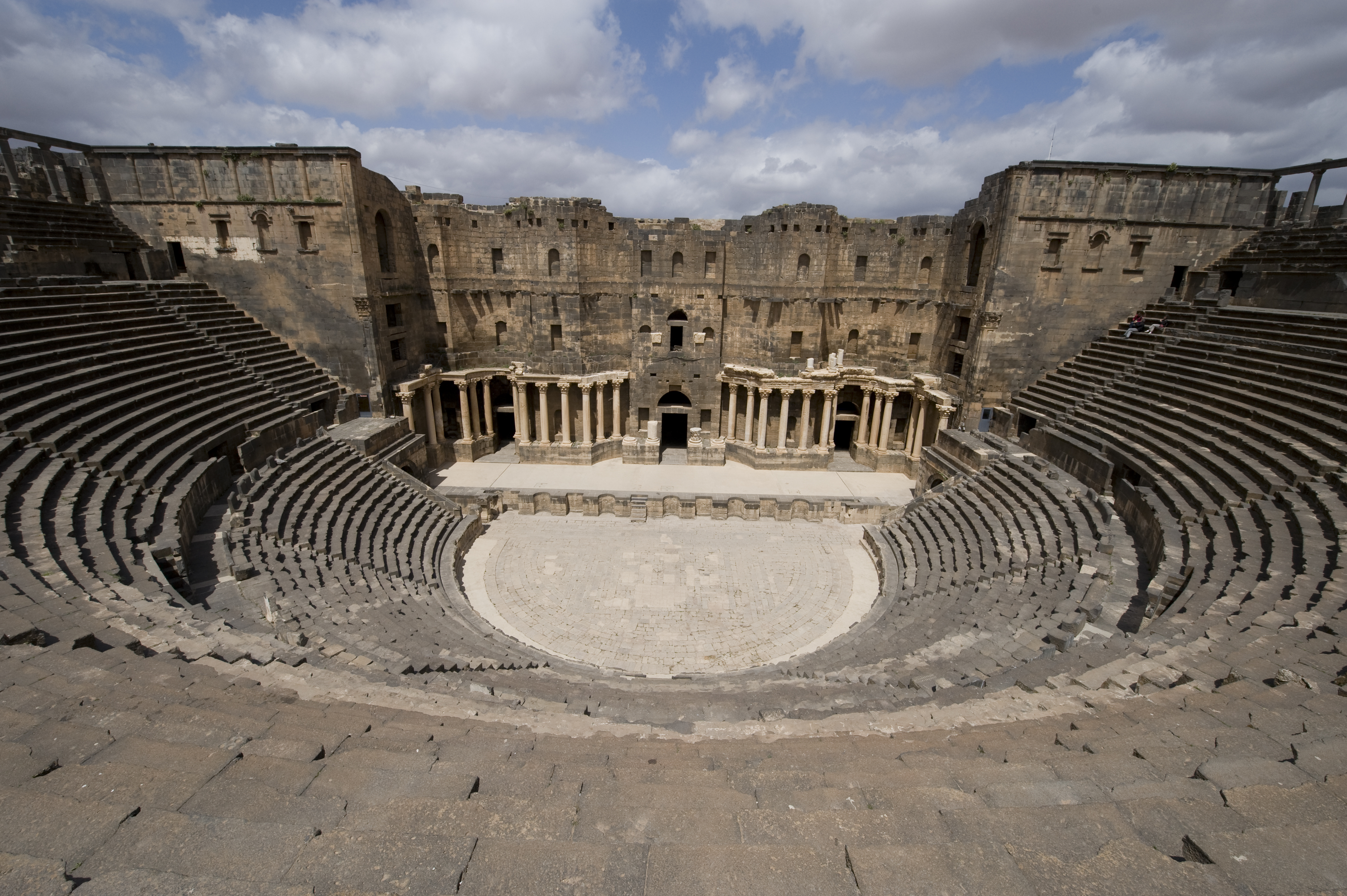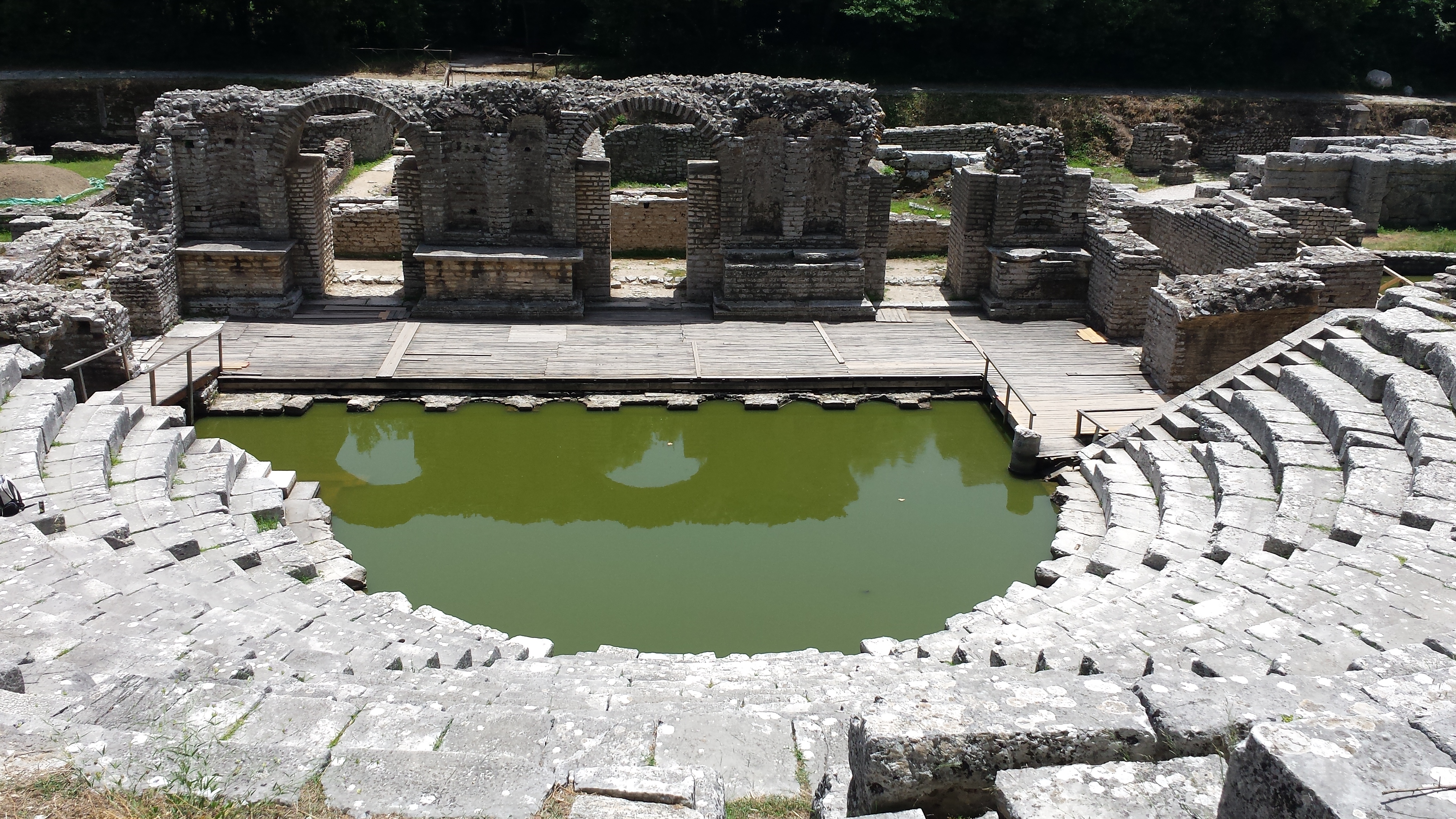|
Roman Theatre Of Bosra
The Roman Theatre at Bosra ( ar, المسرح الروماني ببصرى) is a large Roman theatre in Bosra, in the district of Dar'a in south-western Syria. History It was built in either the second quarter or the second half of the second century AD, and is constructed of black basalt. It is likely that the theatre was built during the reign of Trajan. The theatre was originally built outside the walls of the town, but was later completely enclosed by an Ayyūbid fortress. The city of Bosra had its fortifications expanded between 481 and 1251. When later integrated into the fortifications, its role was to serve as a citadel and to guard a road leading to Damascus. The theatre is 102 metres across and has seating for about 17,000 people; it is thus among the largest of the Ancient Roman civilisation. It served a city that once had 80,000 inhabitants. It is also one of the best preserved both in Syria and across the Roman empire. It was substantially restored between 1947 a ... [...More Info...] [...Related Items...] OR: [Wikipedia] [Google] [Baidu] |
Bosra
Bosra ( ar, بُصْرَىٰ, Buṣrā), also spelled Bostra, Busrana, Bozrah, Bozra and officially called Busra al-Sham ( ar, بُصْرَىٰ ٱلشَّام, Buṣrā al-Shām), is a town in southern Syria, administratively belonging to the Daraa District of the Daraa Governorate and geographically part of the Hauran region. According to the Syria Central Bureau of Statistics (CBS), Bosra had a population of 19,683 in the 2004 census. It is the administrative center of the ''nahiyah'' ("subdistrict") of Bosra which consisted of nine localities with a collective population of 33,839 in 2004. Bosra has an ancient history and during the Roman era it was a prosperous provincial capital and Metropolitan Archbishopric, under the jurisdiction of Eastern Orthodox Patriarchate of Antioch and All the East. It continued to be administratively important during the Islamic era, but became gradually less prominent during the Ottoman era. It also became a Latin Catholic titular see and the ... [...More Info...] [...Related Items...] OR: [Wikipedia] [Google] [Baidu] |
Bosra Pano Syria
Bosra ( ar, بُصْرَىٰ, Buṣrā), also spelled Bostra, Busrana, Bozrah, Bozra and officially called Busra al-Sham ( ar, بُصْرَىٰ ٱلشَّام, Buṣrā al-Shām), is a town in southern Syria, administratively belonging to the Daraa District of the Daraa Governorate and geographically part of the Hauran region. According to the Syria Central Bureau of Statistics (CBS), Bosra had a population of 19,683 in the 2004 census. It is the administrative center of the ''nahiyah'' ("subdistrict") of Bosra which consisted of nine localities with a collective population of 33,839 in 2004. Bosra has an ancient history and during the Roman era it was a prosperous provincial capital and Metropolitan Archbishopric, under the jurisdiction of Eastern Orthodox Patriarchate of Antioch and All the East. It continued to be administratively important during the Islamic era, but became gradually less prominent during the Ottoman era. It also became a Latin Catholic titular see and the ... [...More Info...] [...Related Items...] OR: [Wikipedia] [Google] [Baidu] |
Buildings And Structures In Daraa Governorate
A building, or edifice, is an enclosed structure with a roof and walls standing more or less permanently in one place, such as a house or factory (although there's also portable buildings). Buildings come in a variety of sizes, shapes, and functions, and have been adapted throughout history for a wide number of factors, from building materials available, to weather conditions, land prices, ground conditions, specific uses, prestige, and aesthetic reasons. To better understand the term ''building'' compare the list of nonbuilding structures. Buildings serve several societal needs – primarily as shelter from weather, security, living space, privacy, to store belongings, and to comfortably live and work. A building as a shelter represents a physical division of the human habitat (a place of comfort and safety) and the ''outside'' (a place that at times may be harsh and harmful). Ever since the first cave paintings, buildings have also become objects or canvasses of much artistic ... [...More Info...] [...Related Items...] OR: [Wikipedia] [Google] [Baidu] |
List Of Roman Theatres ...
Roman theatres built during the Roman period may be found all over the Roman Empire. Some were older theatres that were re-worked. See also * Roman architecture * Roman amphitheatre * Theatre of ancient Rome Notes Bibliography * * {{Ancient Roman architecture lists *List Theatres Roman Roman or Romans most often refers to: *Rome, the capital city of Italy *Ancient Rome, Roman civilization from 8th century BC to 5th century AD *Roman people, the people of ancient Rome *''Epistle to the Romans'', shortened to ''Romans'', a letter ... [...More Info...] [...Related Items...] OR: [Wikipedia] [Google] [Baidu] |
List Of World Heritage In Danger
The List of World Heritage in Danger is compiled by the United Nations Educational, Scientific and Cultural Organization (UNESCO) through the World Heritage Committee according to Article 11.4 of the World Heritage Convention,Full title: ''Convention concerning the protection of the World Cultural and Natural Heritage'' which was established in 1972 to designate and manage World Heritage Sites. Entries in the list are threatened World Heritage Sites for the conservation of which major operations are required and for which "assistance has been requested". The list is intended to increase international awareness of the threats and to encourage counteractive measures. Threats to a site can be either proven imminent threats or potential dangers that could have adverse effects on a site. In the case of natural sites, ascertained dangers include the serious decline in the population of an endangered or other valuable species or the deterioration of natural beauty or scientific value o ... [...More Info...] [...Related Items...] OR: [Wikipedia] [Google] [Baidu] |
UNESCO
The United Nations Educational, Scientific and Cultural Organization is a specialized agency of the United Nations (UN) aimed at promoting world peace and security through international cooperation in education, arts, sciences and culture. It has 193 member states and 12 associate members, as well as partners in the non-governmental, intergovernmental and private sector. Headquartered at the World Heritage Centre in Paris, France, UNESCO has 53 regional field offices and 199 national commissions that facilitate its global mandate. UNESCO was founded in 1945 as the successor to the League of Nations's International Committee on Intellectual Cooperation.English summary). Its constitution establishes the agency's goals, governing structure, and operating framework. UNESCO's founding mission, which was shaped by the Second World War, is to advance peace, sustainable development and human rights by facilitating collaboration and dialogue among nations. It pursues this objective t ... [...More Info...] [...Related Items...] OR: [Wikipedia] [Google] [Baidu] |
Damascus
)), is an adjective which means "spacious". , motto = , image_flag = Flag of Damascus.svg , image_seal = Emblem of Damascus.svg , seal_type = Seal , map_caption = , pushpin_map = Syria#Mediterranean east#Arab world#Asia , pushpin_label_position = right , pushpin_mapsize = , pushpin_map_caption = Location of Damascus within Syria , pushpin_relief = 1 , coordinates = , subdivision_type = Country , subdivision_name = , subdivision_type1 = Governorate , subdivision_name1 = Damascus Governorate, Capital City , government_footnotes = , government_type = , leader_title = Governor , leader_name = Mohammad Tariq Kreishati , parts_type = Municipalities , parts = 16 , established_title = , established_date ... [...More Info...] [...Related Items...] OR: [Wikipedia] [Google] [Baidu] |
Syria
Syria ( ar, سُورِيَا or سُورِيَة, translit=Sūriyā), officially the Syrian Arab Republic ( ar, الجمهورية العربية السورية, al-Jumhūrīyah al-ʻArabīyah as-Sūrīyah), is a Western Asian country located in the Eastern Mediterranean and the Levant. It is a unitary republic that consists of 14 governorates (subdivisions), and is bordered by the Mediterranean Sea to the west, Turkey to the north, Iraq to the east and southeast, Jordan to the south, and Israel and Lebanon to the southwest. Cyprus lies to the west across the Mediterranean Sea. A country of fertile plains, high mountains, and deserts, Syria is home to diverse ethnic and religious groups, including the majority Syrian Arabs, Kurds, Turkmens, Assyrians, Armenians, Circassians, Albanians, and Greeks. Religious groups include Muslims, Christians, Alawites, Druze, and Yazidis. The capital and largest city of Syria is Damascus. Arabs are the largest ethnic group, and Mu ... [...More Info...] [...Related Items...] OR: [Wikipedia] [Google] [Baidu] |
Citadel
A citadel is the core fortified area of a town or city. It may be a castle, fortress, or fortified center. The term is a diminutive of "city", meaning "little city", because it is a smaller part of the city of which it is the defensive core. In a fortification with bastions, the citadel is the strongest part of the system, sometimes well inside the outer walls and bastions, but often forming part of the outer wall for the sake of economy. It is positioned to be the last line of defence, should the enemy breach the other components of the fortification system. The functions of the police and the army, as well as the army barracks were developed in the citadel. History 3300–1300 BC Some of the oldest known structures which have served as citadels were built by the Indus Valley civilisation, where citadels represented a centralised authority. Citadels in Indus Valley were almost 12 meters tall. The purpose of these structures, however, remains debated. Though the structures foun ... [...More Info...] [...Related Items...] OR: [Wikipedia] [Google] [Baidu] |
Ayyūbid
The Ayyubid dynasty ( ar, الأيوبيون '; ) was the founding dynasty of the medieval Sultanate of Egypt established by Saladin in 1171, following his abolition of the Fatimid Caliphate of Egypt. A Sunni Muslim of Kurdish origin, Saladin had originally served Nur ad-Din of Syria, leading Nur ad-Din's army in battle against the Crusaders in Fatimid Egypt, where he was made Vizier. Following Nur ad-Din's death, Saladin was proclaimed as the first Sultan of Egypt, and rapidly expanded the new sultanate beyond the frontiers of Egypt to encompass most of the Levant (including the former territories of Nur ad-Din), in addition to Hijaz, Yemen, northern Nubia, Tarabulus, Cyrenaica, southern Anatolia, and northern Iraq, the homeland of his Kurdish family. By virtue of his sultanate including Hijaz, the location of the Islamic holy cities of Mecca and Medina, he was the first ruler to be hailed as the Custodian of the Two Holy Mosques, a title that would be held by all subsequent S ... [...More Info...] [...Related Items...] OR: [Wikipedia] [Google] [Baidu] |






.jpg)
